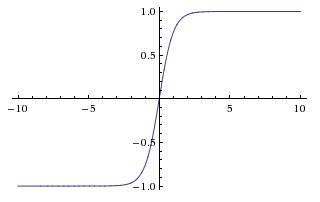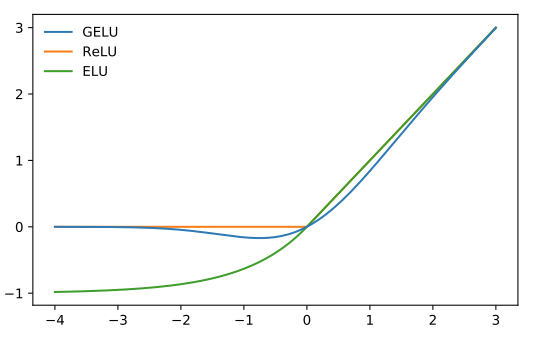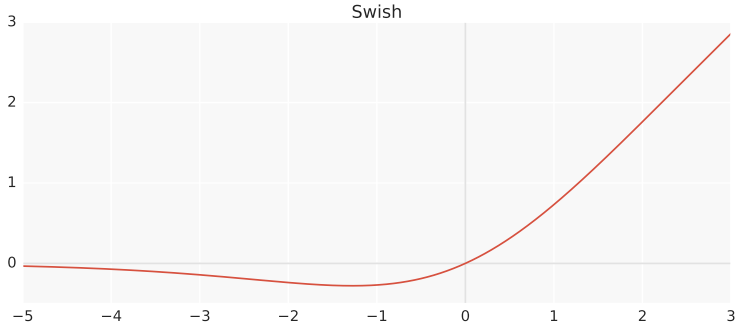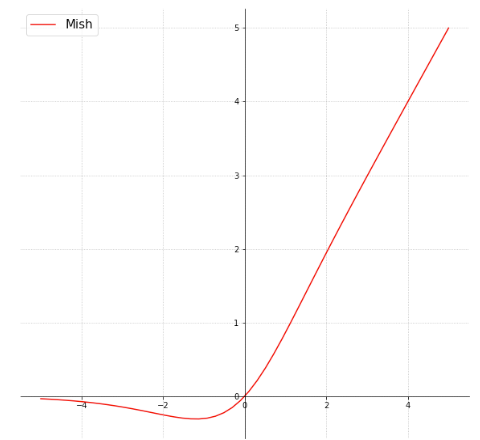Activation functions lead to non-linearity in neural networks. Most common types are Sigmoid, Tanh, Relu, etc.
Commonly-used Activations
Sigmoid
Sigmoid function takes a real-valued number and ‘squashes’ it into the range (0,1).
Drawbacks:
- Sigmoids
saturate and kill gradients. When at either the tail of 0 or 1, the gradient is almost zero. Take care of the weight initialization: if too large most neurons would saturate soon and the networks will barely learn. - Outputs are not zero-centered.

Tanh
Tanh squashes the real number input into the range [-1,1].
- Like sigmoid, its activations saturate;
- but the output of tanh is zero-centered. Therefore,
tanhnon-linearity is always preferred to the sigmoid non-linearity. - $\tanh$ is simply a
scaled sigmoidneuron:

ReLU (Rectified Linear Unit)
ReLu is simply thresholded at zero.
Pros:
- 6x accecerate the convergence of SGD compared to the tanh functions.[2]
- No expensive operations (e.g. exponential)
Problems: - Fragile during training and can “die”: ReLU units can irreversibly die during training.

Leaky ReLU
Leaky ReLU attempts to fix the dying ReLU problem, by setting a small nagative slope when $x<0$. However, the consistency of the benefits across tasks is unclear.
PReLU
Parametric ReLU
where $\alpha$ is learnable.
ELU (Exponential Linear Units)
ELU [4]
Maxout
See Maxout Networks(Goodfellow et.al 2013)[3] :
GELU (Gaussian Error Linear Units)
Motivation:
- combine the properties of dropout, zoneout, and ReLUs.[5]
- multiplying the input by zero or one, but the values of this zero-one mask are stochastically determined while also dependent upon the input.
Specically, multiply the neuron input $x$ by $m \sim \text{Benoulli}(\Phi(x))$, where $\Phi(x)=P(X \leq x)$, $X \sim \mathcal{N}(0,1)$.
The non-linearity is the expected transformation of the stochastic regularizer on an input $x$:
$\Phi(x) \times I x + (1-\Phi(x)) \times 0x = x \Phi(x)$
Then define the Gaussian Error Linear Unit (GELU) as:
BERT implementation:1
2
3
4
5
6
7
8
9
10
11
12def gelu(x):
"""Gaussian Error Linear Unit.
This is a smoother version of the RELU.
Original paper: https://arxiv.org/abs/1606.08415
Args:
x: float Tensor to perform activation.
Returns:
`x` with the GELU activation applied.
"""
cdf = 0.5 * (1.0 + tf.tanh(
(np.sqrt(2 / np.pi) * (x + 0.044715 * tf.pow(x, 3)))))
return x * cdf

Swish
Swish has the property of one-sided boundaries at zero, smoothness and non-monotonicity. Swish is shown to outperform ReLU on many tasks.[6]

Personally, this idea is borrowed from the work of (Dauphin et. al, 2017)[7] at FAIR in 2017, Gated Linear Unit(GLU) in gated CNNs, which is used to capture the sequential information after temporal convolutions:
. In Proceedings of the 34th International Conference on Machine Learning-Volume 70 (pp. 933-941). JMLR. org.">[7]</span></a></sup>](/notes/images/GLU.png)
Relu can be seen as a simplication of GLU, where the activation of the gate depends on the sign of the input:
The gradient of LSTM-style gating of Gated Tanh Unit (GTU) is gradually vanishing because of the downscaling factors $\color{salmon}{\tanh’(\pmb{X})}$ and $\color{salmon}{\sigma’(\pmb{X})}$:
GLU has the path $\color{green}{\nabla \pmb{X} \otimes \sigma(\pmb{X})}$, which does not downscale the activated gating unit. This can be thought as a multiplicative skip connection.
1 | import torch.nn.functional as F |
Mish
Mish is a non-monotonic, self-gated/regularized, smoothing activation function. It is shown to outperform Swish and ReLU on various tasks.[8]

References
- 1.http://cs231n.github.io/neural-networks-1/ ↩
- 2.Nair, V., & Hinton, G. E. (2010). Rectified linear units improve restricted boltzmann machines. In Proceedings of the 27th international conference on machine learning (ICML-10) (pp. 807-814). ↩
- 3.Goodfellow, I. J., Warde-Farley, D., Mirza, M., Courville, A., & Bengio, Y. (2013). Maxout networks. arXiv preprint arXiv:1302.4389. ↩
- 4.Clevert, D. A., Unterthiner, T., & Hochreiter, S. (2015). Fast and accurate deep network learning by exponential linear units (ELUs). arXiv preprint arXiv:1511.07289. ↩
- 5.Hendrycks, D., & Gimpel, K. (2016). Gaussian Error Linear Units (GELUs). arXiv preprint arXiv:1606.08415. ↩
- 6.Ramachandran, P., Zoph, B., & Le, Q. V. (2017). Swish: a self-gated activation function. arXiv preprint arXiv:1710.05941. ↩
- 7.Dauphin, Y. N., Fan, A., Auli, M., & Grangier, D. (2017, August). Language modeling with gated convolutional networks. In Proceedings of the 34th International Conference on Machine Learning-Volume 70 (pp. 933-941). JMLR. org. ↩
- 8.Misra, D. (2019). Mish: A Self Regularized Non-Monotonic Neural Activation Function. arXiv preprint arXiv:1908.08681. ↩
